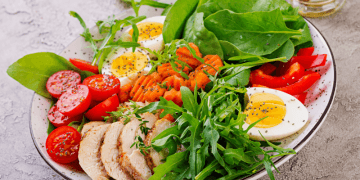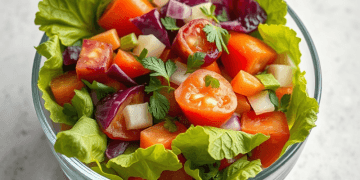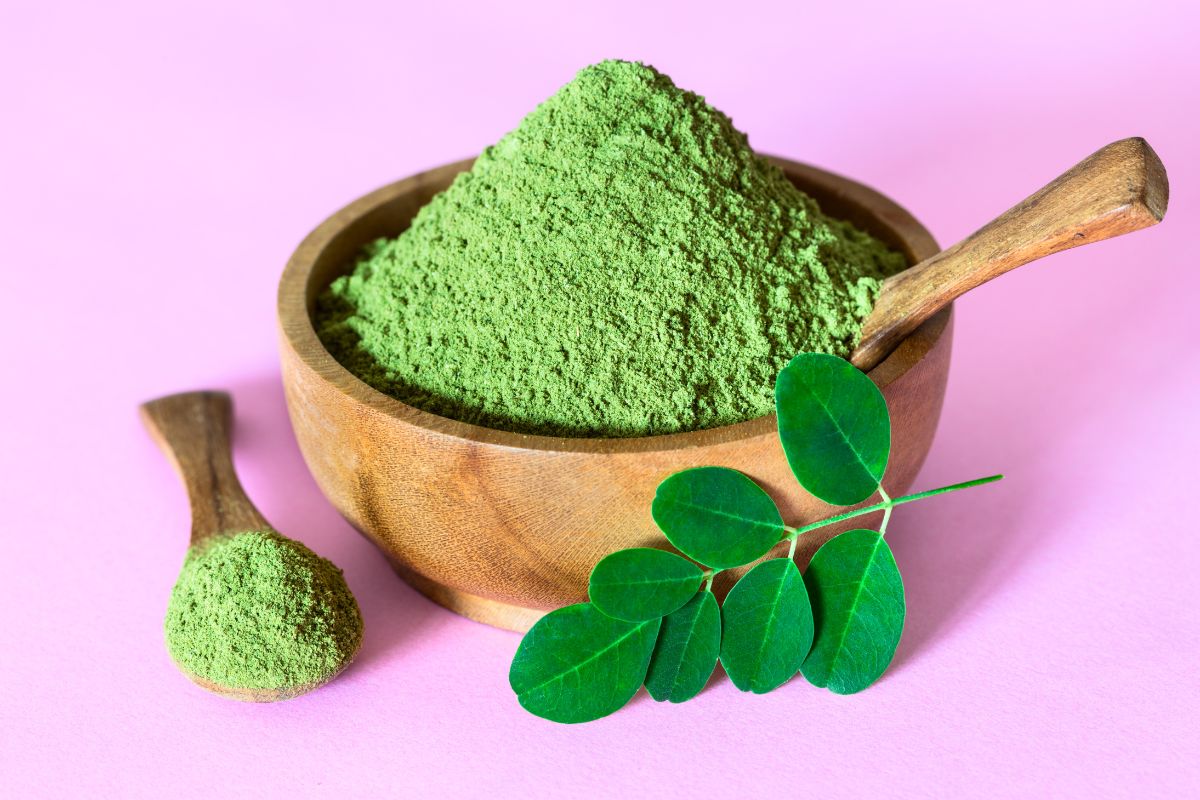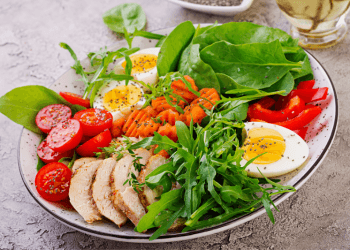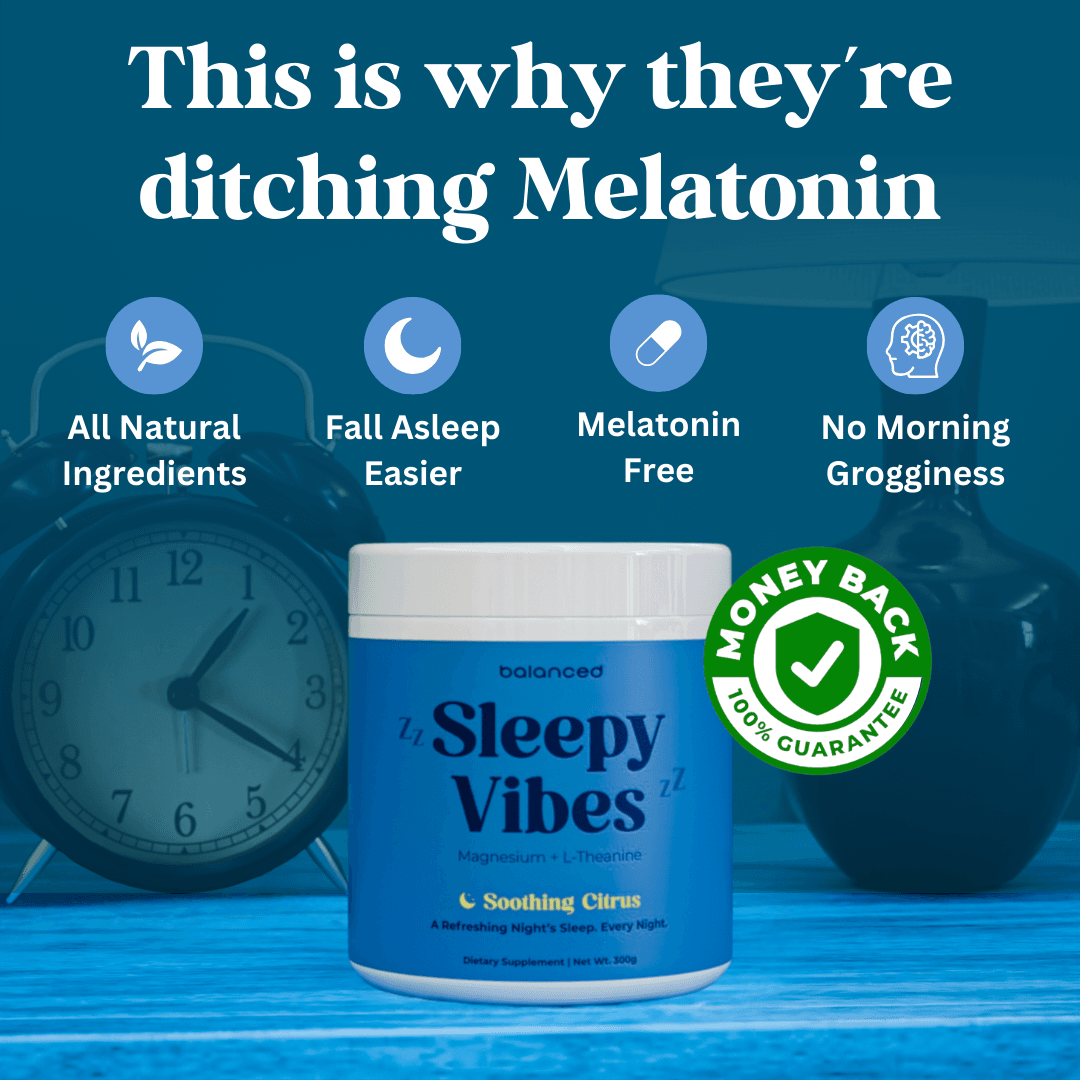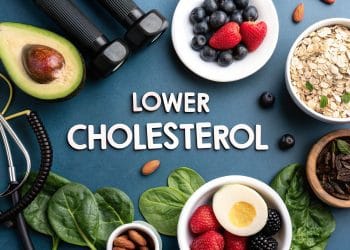Last Updated on June 28, 2025 by Lauretta Iyamu, PharmD
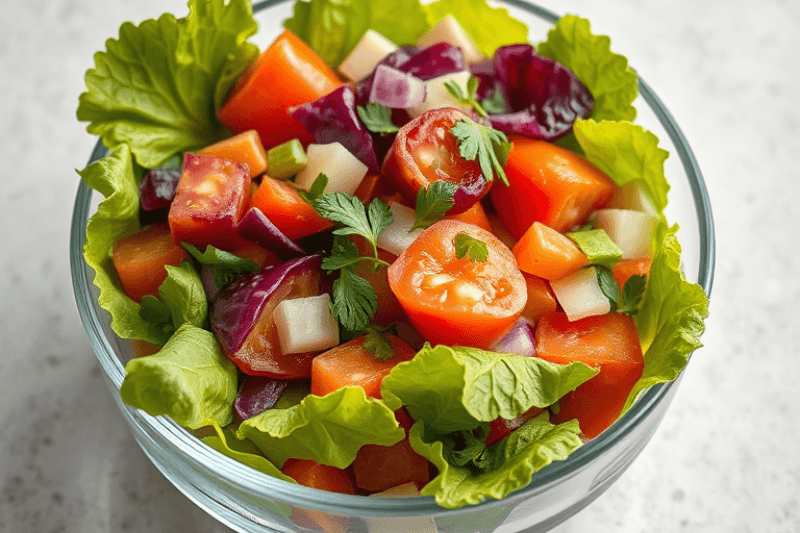
Salads have a reputation for being healthy, yet many of us struggle to eat enough vegetables.
Did you know nearly 75% of adults don’t get their recommended daily greens?
It’s easy to buy fresh lettuce with the best intentions, only to find it limp and forgotten in the fridge.
But eating more salads doesn’t require endless chopping or boring bowls.
These are the 15 simple hacks you need to eat more salads confidently, even on your busiest days, and keep them in your routine for good.
With a few simple strategies, salads can become meals you look forward to, rather than avoid.
Meal Prep Hacks to Help You Eat More Salads Without the Hassle
Preparing salads ahead of time makes them almost effortless to enjoy any day of the week.
1. Layer Salads in Jars
Start with dressing at the bottom, then add firm vegetables, followed by proteins or grains, and finish with fresh greens.
When you’re ready to eat, shake or pour crispy and delicious every time.
2. Wash and Store Greens Properly
A salad spinner is your friend.
After washing, spin the greens until they are dry, then layer paper towels in an airtight container.
The towels absorb moisture and help greens stay crisp for up to five days.
3. Chop Once, Eat All Week
Carve out 15 minutes on Sunday to chop common salad veggies like cucumbers, peppers, and carrots.
Store them in sealed containers so assembling your salad later takes only minutes.
4. Build DIY Salad Kits
Divide your fridge into grab-and-go sections with portions of greens, toppings, proteins, and dressing.
Toss them together at mealtime for an instant healthy lunch.
5. Freeze Prepped Add-Ins
Make extras of roasted chickpeas, cooked quinoa, or grilled chicken.
Freeze in portions so you always have tasty salad boosters ready to thaw.
Flavor Tricks That Make Salads Taste Incredible
Most salads fail because they lack flavor and texture.
These simple additions help your salads shine:
Use a Balanced Dressing
Combine oil, lemon juice or vinegar, and a pinch of salt for a classic base.
Mix in mustard or honey for extra depth and balance.
Include Crunchy Toppings
Add toasted nuts, seeds, or roasted chickpeas.
The texture turns each bite into something to savor.
Add Warm Components
Roast vegetables, warm proteins, or sautéed mushrooms bring home-style satisfaction to cold greens.
Use Fresh Herbs
Parsley, basil, cilantro, and dill bring brightness and freshness to the dish.
Chop a handful into every salad for added flavor.
Pair Sweet and Savory
Fresh fruit, such as berries, grapes, or apples, adds a sweet flavor.
Balance it with cheese or salty olives for a satisfying mix.
Boost Umami
A sprinkle of sun-dried tomatoes, olives, Parmesan, or a touch of miso adds depth and makes your salad taste rich.
Mix Hot and Cold Ingredients
A salad combining chilled greens with warm vegetables or protein feels gourmet and satisfying, with minimal effort.
Psychology Hacks That Help You Eat More Salads Day After Day
Building a habit around salad doesn’t require brute force; it works best when it fits smoothly into your everyday life.
1. Eat A Salad First
Start your meal by eating a small salad bowl.
This helps fill you up with nutritious veggies before richer foods, making healthy choices easier.
2. Make Salad Unmissable
Place salad bowls or kits at eye level in your fridge.
Visibility matters.
If you can see them, you’re more likely to grab them.
3. Reward Good Habits
Create a small celebration after salad streaks, maybe it’s a soothing herbal tea, a short walk, or a new container.
When eating salads feels rewarding, it becomes a habit you can stick to.
Shopping Strategies to Eat More Salads on Repeat
A little planning ahead can make salads a seamless part of your daily routine.
Choose the Right Greens
Opt for sturdy leaves, such as spinach, kale, or mixed greens, that stay crisp for longer.
They save both money and effort.
Go for Budget-Friendly Veggies
Vegetables like carrots, cabbage, and onions are not only flavorful but also nutritious and affordable.
Keep them stocked to build hearty salads.
Buy in Season
Choose seasonal vegetables; they’re cheaper, fresher, and taste better.
Mix Pre-Washed and Whole
For quick meals, grab pre-washed greens.
For bigger salads, buy whole heads; they are more economical and keep longer.
Build a Salad Pantry
Stock up on staples, such as canned beans, olives, nuts, seeds, and dried fruit.
They make it easy to build a satisfying bowl at any time.
Substitution Made Easy
No cucumber? Use celery.
No avocado? Go for cheese.
Having smart swaps in mind ensures you can always enjoy salads, even when missing ingredients.
Kitchen Tools That Make Salad Prep Simple
These simple tools help streamline your salad prep and make eating greens feel effortless.
-
Sharp Kitchen Knife or Mandoline
Consistent chopping makes salads easier and more visually appealing. -
Salad Spinner
Keeps greens dry and crisp, no more soggy leaves. -
Air-tight Glass Containers
Keeps salads fresh in the fridge and makes them look appealing. -
Portable Salad Gear
Mason jars and lunchboxes designed for salads make mealtime convenient, whether at home or on the go.
Fun Salad Ideas That Don’t Feel Like Diet Food
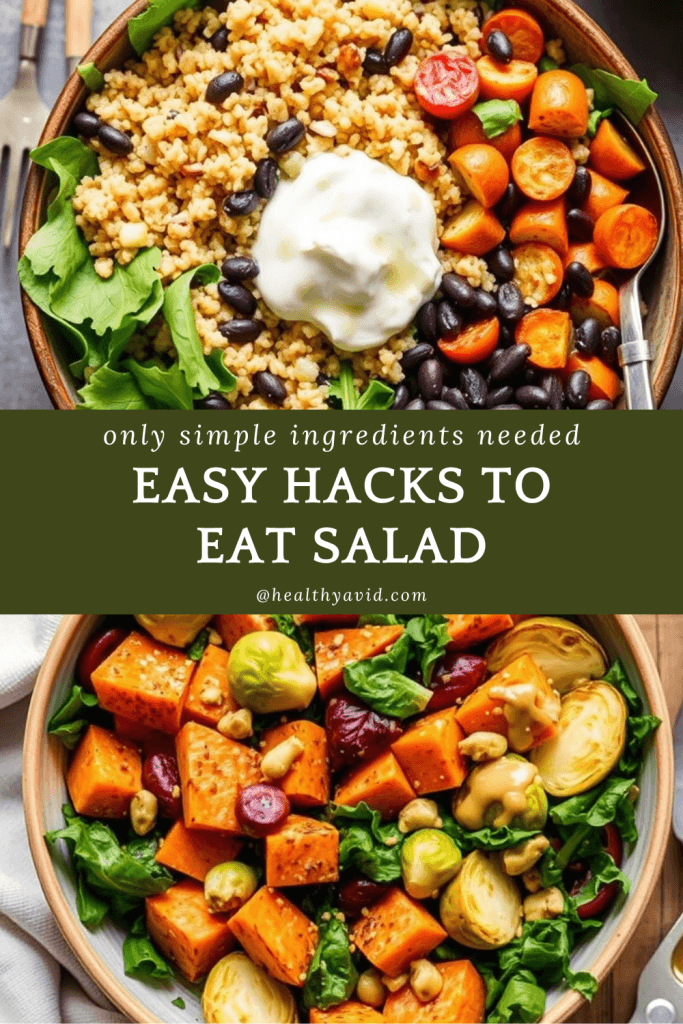
Salads can be exciting, satisfying meals that don’t scream “health food.”
Hearty Grain Bowls
Mix quinoa or farro, black beans, roasted veggies, and greens with a light dressing.
These are filling without being heavy.
Warm Winter Salad
Combine roasted sweet potatoes, Brussels sprouts, kale, and a drizzle of tahini for a cozy, comforting dish.
Breakfast Salad
Start your morning with a bowl of spinach, egg, avocado, and a drizzle of olive oil to boost your energy from the start.
Dessert-Inspired Salad
Toss berries, mint, Greek yogurt, and honey for a lighter, healthier sweet option.
International Flavor Bowls
Think Mexican (corn, beans, avocado) or Mediterranean (olives, tomatoes, feta, cucumber) to mix up ingredients and flavors.
Zero-Waste Leftover Bowls
Add leftover grilled chicken, roasted vegetables, or grains to your greens for a quick and tasty meal.
Party-Worthy Salads
Serve a layered bean salad or a colorful chopped bowl at gatherings; it’s nutritious and crowd-pleasing.
Kid-Friendly Rainbow Bowls
Use colorful veggies, cheese, and crunchy toppings.
Lettuce wraps or mini salad cups can make salads fun and accessible for children.
Health Benefits of Eating More Salads
Eating more salads does more than help you eat vegetables.
It gives your body powerful tools to stay healthy, strong, and full of energy.
A salad made with fresh greens, colorful vegetables, healthy fats, and lean proteins is like giving your body a daily gift.
Here’s what that gift includes:
-
Better Digestion: Salads are rich in fiber, which helps your stomach and intestines function properly. Fiber helps keep you regular and prevents bloating.
-
More Energy: Fresh veggies are packed with vitamins and minerals your body needs to stay alert and focused throughout the day.
-
Stronger Immunity: Leafy greens like spinach and kale give you nutrients like vitamin C and antioxidants that help your body fight off sickness.
-
Weight Support: Salads help you feel full without eating too many calories. This makes it easier to manage your weight in a healthy manner.
-
Glowing Skin and Hair: The vitamins in vegetables help your skin look fresh and your hair grow strong.
-
Protection from Disease: A diet rich in vegetables may help reduce your risk of heart problems, diabetes, and even some cancers.
When you start adding more salads to your meals, your whole body starts to notice the difference.
Common Mistakes That Make Salads Boring (And How to Fix Them)
Salads are supposed to be fresh and fun, but sometimes they feel more like a chore.
That usually happens when a few common mistakes sneak in.
Let’s fix them so your salads never feel boring again.
Mistake #1: Using the Same Greens Every Time
Lettuce is great, but using it every day can get old.
Mix it up with spinach, arugula, kale, or even shredded cabbage for a variety of flavors.
Different greens have different textures and tastes.
Fix: Try using two or three greens together.
This makes your salad more exciting and provides your body with additional nutrients.
Mistake #2: Forgetting the Flavor
If your salad tastes bland, it’s probably missing flavor boosters like herbs, dressings, or a pinch of salt.
Fix: Add fresh herbs like basil or cilantro.
Use dressings with a balance of fat, acid, and seasoning, like olive oil and lemon juice with a sprinkle of salt.
Mistake #3: Skipping the Crunch
Soft veggies alone can make a salad feel flat.
Fix: Add something crunchy.
Try nuts, seeds, roasted chickpeas, or toasted pita chips.
Mistake #4: Leaving Out Protein
Without protein, salads might not keep you full for long.
Fix: Add grilled chicken, hard-boiled eggs, beans, tuna, or tofu to turn your salad into a full meal.
Mistake #5: Not Enough Variety
Eating the same salad over and over makes anyone bored.
Fix: Change up your toppings.
Add fruits like apples or berries, roasted veggies, grains like quinoa, or a new dressing.
Even small changes can make a big difference.
Salad Toppings That Make a Big Difference Without Extra Calories
Toppings are where salads go from “okay” to “wow.”
However, many store-bought dressings or crispy bits can contain extra sugar, salt, or fat.
The good news is that you don’t need heavy toppings to make your salad taste amazing.
Here are smart swaps that boost flavor, crunch, and nutrition without weighing down your salad.
Crunch Without Croutons
Instead of greasy croutons, try these light but crispy options:
-
Toasted seeds: Pumpkin or sunflower seeds add crunch and healthy fats.
-
Roasted chickpeas: A handful adds protein and texture to your salad.
-
Sliced radishes or cucumbers: Naturally crisp and low in calories.
-
Shredded cabbage: Adds bite and stays crunchy even with dressing.
Flavor Without Extra Fat
Skip high-calorie cheese and bacon bits. These give you flavor without overdoing it:
-
Fresh herbs: Basil, parsley, mint, or dill wake up your salad with fresh flavor.
-
Zest: A little lemon or orange zest adds bright citrus notes without sugar.
-
Vinegar: A splash of balsamic, apple cider, or red wine vinegar can lift the whole dish.
-
Spices: A pinch of chili flakes, cumin, or curry powder adds bold flavor quickly.
Creaminess Without Cream
Creamy salads can still be healthy. Try:
-
Mashed avocado: A spoonful adds healthy fat and a rich texture.
-
Hummus dollop: Great on Mediterranean-style salads.
-
Plain Greek yogurt dressing: Mix with herbs and lemon juice for a light, creamy drizzle.
These toppings don’t just add variety, they help you build a satisfying salad that keeps you full and happy.
How to Build a Salad That Feels Like a Full Meal
Sometimes salads leave you hungry an hour later.
That’s usually because they’re missing one key thing: balance.
A good salad should fill you up and keep you going.
Here’s how to build a satisfying, nutrient-rich salad that feels like a full meal.
1. Start with a Big Base of Leafy Greens
Choose greens you enjoy and mix them up for texture and taste:
-
Romaine: Crunchy and refreshing
-
Spinach: Soft and full of iron
-
Kale: Hearty and fiber-rich
-
Mixed greens: A great all-in-one base
Try using 2 to 3 cups of greens to add volume to your salad without many calories.
2. Add a Protein Source
Protein helps you stay full and supports your muscles. Easy choices include:
-
Grilled chicken or turkey
-
Hard-boiled eggs
-
Tuna or salmon
-
Tofu or tempeh (for a plant-based option)
-
Cooked beans like black beans or chickpeas
Aim for about 3 to 4 ounces of protein per salad.
3. Don’t Forget Healthy Carbs
Carbohydrates give your body energy, especially when they’re the good kind:
-
Sweet potatoes (roasted or steamed)
-
Quinoa, brown rice, or farro
-
Corn or peas
-
Whole grain croutons in moderation
Adding ½ cup of whole grains makes a big difference in how filling your salad feels.
4. Include Healthy Fats
Good fats help your body absorb vitamins and support your brain and heart:
-
Avocado slices
-
Olive oil in your dressing
-
Chopped nuts or seeds
-
Olives or a spoonful of hummus
A little fat (about 1 to 2 tablespoons) makes your salad more satisfying.
5. Add Flavor and Crunch
Round out your salad with color, texture, and taste:
-
Chopped apples or pears
-
Sliced cucumbers, carrots, or radishes
-
Roasted veggies like beets or bell peppers
-
Fresh herbs, lemon juice, or a simple homemade dressing
Building your salad this way turns it into a complete, balanced meal.
It’s not just a side, it’s the star of your plate.
Common Mistakes That Make Salads Less Healthy (and How to Fix Them)
Salads should be good for you.
But sometimes, even the healthiest-looking bowl can be packed with hidden sugars, fats, or empty calories.
Here are a few common mistakes and their easy fixes.
Mistake 1: Using Too Much Dressing
Store-bought dressings often contain added sugars, unhealthy oils, and preservatives.
Pouring on too much can turn your light salad into a heavy meal.
Fix it: Make your dressing at home using olive oil, vinegar or lemon juice, mustard, and herbs.
If using bottled dressing, use only 1 or 2 tablespoons.
Mistake 2: Adding Too Many Toppings
Croutons, bacon bits, fried onions, and creamy cheeses can add extra fat, salt, and calories fast.
Fix it: Choose 1 or 2 toppings at most, and balance them with healthier options like nuts, seeds, or roasted chickpeas.
Mistake 3: Forgetting Protein
If your salad consists only of vegetables, it may not be filling.
This leads to snacking later and feeling unsatisfied.
Fix it: Always include a lean protein source, such as grilled chicken, beans, or tofu.
It helps you stay full and keeps your energy steady.
Mistake 4: Making It Too Small
Tiny salads won’t hold you over until your next meal.
Fix it: Use at least 2–3 cups of greens, add a protein source, a healthy fat, and some carbohydrates.
Think of your salad as a complete meal, not just a snack.
Mistake 5: Skipping the Seasoning
A salad with no flavor will leave you bored and craving something else.
Fix it: Add a little salt, pepper, herbs, citrus juice, or vinegar to make a big difference.
Try adding fresh basil, cilantro, or dill for a flavor upgrade.
Avoiding these small mistakes helps you get the most out of every salad, more nutrition, better taste, and longer-lasting satisfaction.
Conclusion
You don’t have to be a veggie lover to enjoy a good salad; you need a few smart strategies.
With the right prep hacks, tasty toppings, and kitchen shortcuts, salads become something you look forward to, not something you dread.
Every bowl of greens is a chance to boost your energy, support your digestion, and give your body the nutrients it truly needs.
Over time, these small habits create lasting health, without stress, guilt, or boring meals.
So take the first step.
Try one new hack this week.
See how easy it can be to feel good with every bite.
What’s the first salad trick you’re excited to try?
Let us know in the comments!




















